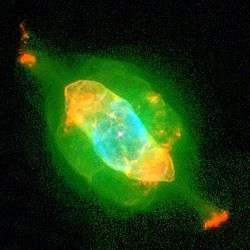
Saturn Nebula
The Saturn Nebula or NGC 7009 is a planetary nebula in the constellation Aquarius. It appears as a greenish-yellowish hue in a small amateur telescope. It was discovered by William Herschel on September 7, 1782, using a telescope of his own design in the garden at his home in Datchet, England, and was one of his earliest discoveries in his sky survey. The nebula was originally a low-mass star that ejected its layers into space, forming the nebula. The central star is now a bright white dwarf star of apparent magnitude 11.5. The Saturn Nebula gets its name from its superficial resemblance to the planet Saturn with its rings nearly edge-on to the observer. It was so named by Lord Rosse in the 1840s, when telescopes had improved to the point that its Saturn-like shape could be discerned. William Henry Smyth said that the Saturn Nebula is one of Struve's nine "Rare Celestial Objects."
The Saturn Nebula is a complex planetary nebula and contains many morphological and kinematic sub-systems in three dimensions. It includes a halo, jet-like streams, multiple shells, ansae ("handles"), and small-scale filaments and knots. The ansae are expanding non-radially from the central star. Although the ansae are most prominent in the Saturn Nebula, they are also visible in other planetary nebulae, including NGC 3242, NGC 6543 and NGC 2371-2.